The Straight Arm Double Lapel Grab, Part 2
By Christopher Caile
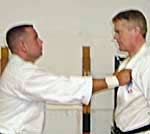
Introduction
This article is a continuation to the first part of this series, "The
Straight Arm Double Lapel Grab, Part 1." Both articles address
the situation where an attacker grabs the jacket lapel or shirt on both
sides, but then holds the defender at arm's length. Part 1 shows a defense
to this attack taken from the karate kata Pinan number four. Part 2 features
a second self-defense technique to the same attack taken from another
kata. These articles complement an earlier article, "The Double Lapel
Grab," which addressed the same grab, but there the attacker pulled
the defender in.
A double lapel grab is not much of an attack. As discussed in Part 1,
it is a somewhat timed attack and often indicates that the attacker really
doesn't want to get into an all out conflict, or isn't sure what to do.
Of course, if this attack is but a prelude to a kick, or a controlling
method to set you up for a follow up strike, then it is more serious.
Thus, you always have to be attentive.
In this article we will assume that you, the defender, have already tried
(see Part I) to diffuse the situation verbally, or did nothing and the
situation eventually diffused itself. You might have also escalated your
measures and tried a painful, but not aggressive, pinch to the underside
of the attacker's extended arms to make him or her let go.
In any self-defense situation, if you can, it is best to proceed through
a "continuum of force," escalating only as far as necessary
to protect yourself. These include:
• Non-Reaction (if applicable).
• Verbal diffusion.
• Physical techniques which may hurt or sting to create the release
itself, but will not harm the aggressor.
• Strikes, kicks, or joint manipulations and other measures to
free yourself and/or control or immobilize.
• Techniques to render the assailant unconscious or incapacitated.
The Defense
Part 1 of this two-part series illustrated self-defenses technique against
the straight arm double lapel grab taken out of Pinan 4. It involved stepping
back or forward with one leg (depending on the action of the attacker),
driving your arms up between the attacker’s outstretched grabbing
arms and then kicking the opponent with the rear leg. This technique illustrates
one of two good solutions to this attack – a kick.(1)
A kick is used because if the defender is significantly smaller and shorter
than the attacker, the defender’s arm reach is too short to hit
the face or head of the attacker.
Follow-up techniques always depend on the attacker's reaction. In the
example given in Part 1 of this series, the attacker let loose of one
arm enabling the defender to follow up with a double punch to the opponent's
head. A different reaction could have just as easily led to a second or
third kick, or a follow up elbow to the head or other technique.
This article (Part 2) illustrates another solution taken from the kata
Seienchin. This technique series can be used alone, or be linked to that
shown in Part 1, as a follow up technique if, after kicking the attacker,
he or she still has hold of your shirt or jacket with both hands.
In Seienchin kata, the defender places his arm (here, the right) across
his or her chest, over the attacker’s left outstretched arm and
under the attacker's right. The fist, now at the defender's left side
at about solar plexus level, is then supported by a left open hand.
To make this technique work, however, the attacker's arms need to be
straight. To insure this situation I prefer to add a right hand slap to
the opponent's face (not seen in the kata) as I am bringing my right arm
across. The opponent's natural reaction is to push his or her arms out
as a defensive reaction to avoid being hit. Thus, even if the defender’s
arms are too short to make contact, the attacker’s reaction will
be the same.
Another technique is to execute a middle front kick (which has greater
range) to the opponent. This will have similar effect. It is also indicated
as a possible move within the kata since in the kata, the defender’s
foot position is a cat stance (one leg pulled back, the heel raised as
if ready to kick).
The Primary Technique
This article (Part 2 of the series) illustrates a second viable solution
to this attack – forcibly rotating (using leverage) the attacker’s
arms into a position so that one is above the other, which not only unbalances
the opponent to the side, but allows the defender to move around the attacker’s
outstretched arms to attack the body, head or limbs of the attacker.
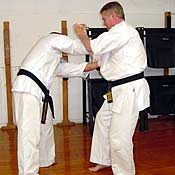 Here
the defender raises his right fist (elbow down close to the body), supported
by his left, in a circular movement upward while also moving his whole
body to the right 45 degrees.(2) The effect
is to pry the opponent's right arm upward almost over his left, unbalance
him to the left and slightly forward, while also putting his weight onto
his left leg. The attacker is now in a very vulnerable position and might
just let go. If so, you would have to decide whether just to walk away
or continue to counter attack depending on the situation. Here
the defender raises his right fist (elbow down close to the body), supported
by his left, in a circular movement upward while also moving his whole
body to the right 45 degrees.(2) The effect
is to pry the opponent's right arm upward almost over his left, unbalance
him to the left and slightly forward, while also putting his weight onto
his left leg. The attacker is now in a very vulnerable position and might
just let go. If so, you would have to decide whether just to walk away
or continue to counter attack depending on the situation.
The weakness that this technique exploits is the fact that extended arms
have little power or ability to resist side to side manipulations. They
may be strong in a push or pull, and are hard to bend, but straight and
extended they have little strength to the sides or up and down. This weakness
is increased when the defender, while turning to the right, also slightly
pulls the attacker’s arms forward creating further unbalance.(3)
Secondary, Follow-up Techniques
In any self-defense situation the defender's primary self-defense technique
opens up possibilities for secondary or follow-up techniques. These may
vary depending on how the attacker reacts. Some follow-up techniques may
preclude others, while others may be used together. Thus in analyzing
kata pay greatest attention to primary techniques while realizing that
any secondary techniques may have to be varied or not used at all if the
attacker reacts differently than expected.(4)
For example, the kata suggests a possible kick into the attacker's left
leg once the right arm has been pried up (5),
but this only works if the defender doesn't pivot with his legs. It also
precludes the other follow up techniques included within the kata.
Now let’s look again at the opponent where we left him. He has
been off-balanced to the side and slightly forward, his weight is on his
left leg, and his right arm has been moved above his left. Two opportunities
immediately present themselves.
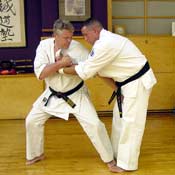 Follow-up
Option 1 - The simplest technique is just to step (or drop)
forward with the left foot into a straddle or horse stance while
pivoting the body to do a left fist downward strike into the opponent's
groin, while your right hand grips the opponent’s right arm,
ideally holding it across the body so the elbow is locked pressed
against your own center. If you can get this arm lock against the
opponent’s elbow, you can easily break it (requires a subtle
body shift). If the elbow instead bends, you at least have control
of the attacker's arm while you strike.(6) Follow-up
Option 1 - The simplest technique is just to step (or drop)
forward with the left foot into a straddle or horse stance while
pivoting the body to do a left fist downward strike into the opponent's
groin, while your right hand grips the opponent’s right arm,
ideally holding it across the body so the elbow is locked pressed
against your own center. If you can get this arm lock against the
opponent’s elbow, you can easily break it (requires a subtle
body shift). If the elbow instead bends, you at least have control
of the attacker's arm while you strike.(6)
|
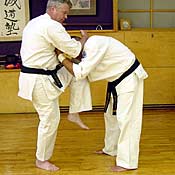 The
kata also suggests a second follow-up technique to the groin strike shown
above. The next movement in the kata is to withdraw the left leg to the
rear into a horse or straddle stance facing the opposite direction. While
beginning this move the right arm is raised in preparation for executing
a right lower block or strike while the left arm is extended downward. The
kata also suggests a second follow-up technique to the groin strike shown
above. The next movement in the kata is to withdraw the left leg to the
rear into a horse or straddle stance facing the opposite direction. While
beginning this move the right arm is raised in preparation for executing
a right lower block or strike while the left arm is extended downward.
In reality this movement breaks down as follows. The right arm that moves
upward and across the body is executed as the left leg is withdrawn. The
middle of this technique has the action. A hidden move in the kata is
that as you begin to shift backwards, the withdrawn left leg rises into
a knee strike to the opponent's face (already lowered in reaction to the
arms being pried to the side and forward, and more so following the groin
strike), while at the same time your right arm hits inward toward yourself
to the back of the opponent's head. This can have a devastating effect.
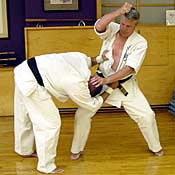
The left leg is then withdrawn into a horse stance, as your left arm
pushes down on the opponent's head, right arm raised. You can then perform
a right downward strike to the neck or side of the head.
Follow-up Option 2 - Let’s go back to the position where
you have leveraged the opponent's right arm above his left. Look at the
photo:
You will notice that the opponent's two arms present a sort of window
through which your left arm can strike. In the kata the practitioner at
this point raises his right arm in preparation for executing a left downward
block. But this movement can contain a lot more. A little modification
turns this movement into a devastating upper cut (through the window of
the opponent’s outstretched arms), hitting the opponent under the
jaw.
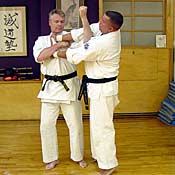 This
again might end it all there and the opponent might just collapse. At
a minimum, you have created a tremendous distraction, and this affects
the opponent’s arms. With attention on the strike and probably occupied
by star bursts going off in his or her head, you can now slide your left
arm into position to attack the elbow. Use the crook of your elbow to
hit sharply upward against the upper arm while straightening your legs
slightly as you simultaneously pull down with your right hand on the opponent's
wrist -- another elbow attack.(7) This
again might end it all there and the opponent might just collapse. At
a minimum, you have created a tremendous distraction, and this affects
the opponent’s arms. With attention on the strike and probably occupied
by star bursts going off in his or her head, you can now slide your left
arm into position to attack the elbow. Use the crook of your elbow to
hit sharply upward against the upper arm while straightening your legs
slightly as you simultaneously pull down with your right hand on the opponent's
wrist -- another elbow attack.(7)
After this you may, if necessary, continue the technique sequence as
shown in "Follow-up Option 1," above. The beauty of this technique
sequence is that many options and opportunities are offered for follow-up
techniques. The attacker will probably just let go at a number of points
along the way during this series of techniques, but maybe not. You also
have lots of options, some more forceful than others.
Footnotes:
(1) A number of other often taught self-defense
measures to the double straight arms grab just don’t work. For example,
some readers suggested using one arm to press down across the attacker’s
two straight arms to bend them, while punching with the other hand to
the face. This just doesn’t work. Aikido people often demonstrate
how an almost straight arm is practically unbendable. Two arms are double
the trouble. And if the defender is smaller and weaker – don’t
even try.
(2) A common mistake made by many karate-ka is
to move their upper body while doing this type of technique while keeping
their feet in place. While this can work, it requires a lot more muscle.
Ideally, when the right fist is raised, it should be kept near the center
of the body while the whole body is turned. This way, the arm is kept
near the center of the body which is its strongest position. It is for
this reason that practitioners of aikido, diato-ryu and many jujutsu systems
always keep their arms (when they are doing techniques) centered at their
middle. It is the same position that Japanese swordsmen hold their swords
as well as the finishing position for many karate blocks. This allows
the defender’s turning body weight --and not just his arms -- to
do the strength work. Whenever the body’s shoulders are not over
its hips, body strength can be lost when applying strength.
(3) This is done within the kata. By rotating
the body 45 degrees, the defender is also slightly pulling the defender
forward. This forward unbalancing movement can also be emphasized if another
stance is used. The other day while getting ready for practice at our
Seido karate headquarters in NYC, I saw one of the instructors, Angel
Alicea, demonstrating a self-defense technique to beginning students that
seemed to be the same technique illustrated here. Later that night I asked
Angel about it and he mentioned that it was a technique he had developed.
Only after mentioning the kata Seienchin did he make the connection. In
his version, however, he added an interesting and effective variation.
When he moved his arms up and over to pry to opponent's right arm above
his left, Angel didn't just pivot 45 degrees to the right (as in the kata)
but also stepped slightly back with his right foot (his feet were in a
natural stance and not in the cat stance as in the kata) to pull the attacker
forward and much more off-balance. This is an effective alternative. It
also shows that good technique is created as often today as it was among
the masters of the past. Moreover it shows that similar techniques may
have been developed over and over again by countless generations of martial
arts practitioners in earlier periods and in different areas of the world.
(4) Equally, an opponent may react differently
depending on how the defender's technique was executed. Thus while practicing
self-defense techniques it is important to practice them over and over
again with a variety of attackers whose size and strength vary. In this
way, you can learn how people react and therefore learn how to perform
the techniques correctly. You also learn alternatives, so when your technique
is faulty or the opponent reacts differently, you have viable technical
solutions.
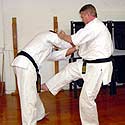 |
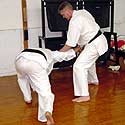 |
(5) Here the defender kicks (right foot) to the
inside of the opponent's leg, just above the knee -- a very sensitive
and painful point which often results in the buckling of the leg. The
kicking surface can be the ball of the foot, the flat underside of the
foot, or as demonstrated here, using the toes. This kick strikes the femoral
nerve that runs down the inside of the thigh. If the inside leg is struck
just above the knee, the leg will often buckle, as illustrated here. The
defender can then simply open his right fist and grasp the attacker’s
right wrist and effect an arm lock on the opponent -- thus executing one
of the two horse stance down block combinations seen in the kata.
(6) If you want to attack the elbow, you have
a second chance. Your left arm after striking down can be brought up inside
the attacker's left arm, your own arm hitting upward (as you also raise
your body) as you pull down with your right arm on the attacker's wrist.
If done with snap and power, the combined impact of going in two directions
can also break or injure the opponent's elbow.
(7) This type of elbow break is very prevalent
in many forms of Chinese combative arts that I have studied, including
Praying Mantis and White Eyebrow (Pak Mei) Kung Fu.
Disclaimer: The techniques demonstrated here are
for informational purposes only. Some of the techniques are extremely
dangerous and should not be attempted or practiced unless under supervision
of a trained karate exponent who also has knowledge of joint locks and
other joint manipulations.
About the Author:
Christopher Caile is the Founder and Editor-In-Chief of FightingArts.com.
He has been a student of the martial arts for over 43 years. He started
karate as a student of Phil Koeppel. Later in Japan he studied under Mas
Oyama and became a US Branch Chief of Kyokushinkai. In 1976 he followed
Kaicho Tadashi Nakamura when he formed Seido karate and is now a 6th degree
black belt in that organization's honbu dojo. Other experience includes
judo, aikido, diato-ryu, kenjutsu, kobudo, Shinto Muso-ryu jodo, boxing
and several Chinese fighting arts as well as Zen. A long-term student
of one branch of Traditional Chinese Medicine, Qigong, he is a personal
disciple of the qi gong master and teacher of acupuncture Dr. Zaiwen Shen
(M.D., Ph.D.) and is Vice-President of the DS International Chi Medicine
Association. He holds an M.A. in International Relations from American
University in Washington D.C. and has traveled extensively through South
and Southeast Asia. In the early 1960's he lived in Japan and has frequently
returned to continue his studies in the martial arts, their history and
tradition. In his professional life he has been a businessman, newspaper
journalist, inventor and entrepreneur. |